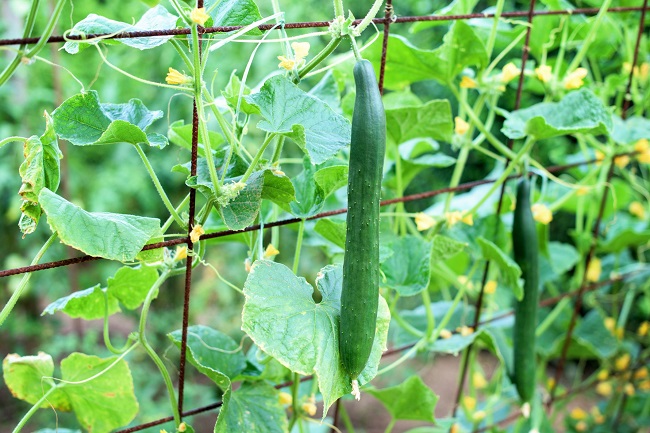At the tail end of a long, hot summer, one more no-cook crop is a necessity. A fruit whose name is synonymous with cool, cucumbers fit the bill for gardeners with abundant space, as well as those of us who work with more limited room, whether indoors or in containers.

Cucumbers are suited to the heat of the summer, most need full sun and no frost. While cucumbers on the ground can take up a lot of space, vertical growing techniques provide the double boon of space management as well as reducing some of the pest and air flow issues that can plague vines on the ground. Additionally, water damage to plants and fruit can be minimized; cucumber plants need consistent moisture through the growing period, but care must be taken not to waterlog leaves and vines. Cucumbers can be trained to trellises or fences or can be caged using a variety of materials. Starting cukes early in the greenhouse can mean two crops over the summer, or a continuous bounty throughout the season if plantings are staggered by a week or two.
Many cucumber plants produce both male and female flowers, so don’t be too alarmed if the first set of flowers falls off the plant with no fruit to show for it. They’re probably male flowers, which tend to show up earlier, and female flowers are the ones who make the fruit. Female flowers are distinguished by a tiny cucumber behind the bloom. To develop this into fruit, the female flowers must be pollinated by male flowers. Some indoor and rooftop gardeners have pollination issues, and many cucumber gardeners pollinate their plants themselves, in effort to aid fruit production. It’s not difficult, but can be time consuming, as a small, never used paintbrush can be used to pick up pollen from the centers of male flowers and deposit it into the female ones.
Some growers avoid this issue altogether by choosing hybrid types that produce only female flowers and self-pollinate. Cucumber plants can produce far more flowers than they can support as fruit, so it doesn’t hurt to remove some off the plant, if you feel that may be hampering fruit production. Later in the growing season, it’s good to remove seriously misshapen fruit from the plant before the plant devotes too much energy to producing it. Once the cucumbers have started to mature, it’s important to pick them frequently and remove over-mature yellow cucumbers from the vine, as these fruits can cause the cucumber plant to stop fruiting. Over-aged cucumbers also become tough and unpleasant to eat if left on the vine.
The two major types of cucumbers are pickling and slicing cucumbers. Pickling varieties have a thinner, blander skin and tend to be smaller, but they’re fine to slice up and use in salad. There are also no laws against using slicing cucumbers as pickles. These two types of cucumbers are almost unlimited in their variety of sizes, from tiny pickling cornichons to massive slicing cucumbers. The popularity of cucumbers throughout the world means there are some unique varieties to try. Though most yellow cucumbers are old, lemon cucumbers are yellow when they’re ripe. They’re shorter than other cucumbers, sweet and mild, and harvested when about the size of their namesake.
Asian varieties, including Japanese, Korean and Chinese types are long and ribbed, ripening at a foot long, but they are also sweet. Grow these trellised for straight fruit. Another variety that is popular with cooks and children alike is the Mexican sour gherkin. These are also called mouse melon in many places, for its tiny watermelon appearance. These are ripe between 1-2 inches and grow on a small drought tolerant plant well-suited to containers. With its faintly sour skin, some claim it tastes like pickles off the vine.
Pickles can be made with a variety of fermented, vinegar packed, freezer and refrigerator recipes, widely available and easier than one might think. Cucumbers also shine in salads, dressings, and relishes. They are popular in creamy sauces and dressings like tzatziki, and a side of sliced cucumbers with a dollop of buttermilk dressing is cooling with spicy foods. For a creamy fresh cucumber dressing, combine a peeled or mostly peeled cucumber in a blender with yogurt, oil and herbs and process until smooth.
A Mexican inspired salad combines chunks of jicama, cucumber, and watermelon (but can also include other melons, orange and pineapple) with lime juice, a faint sprinkle of sugar and a shake of powdered chili pepper. Before adding in a salad like this, cut or slice cucumbers and sprinkle them with salt. Let it sit for a few minutes to draw out excess water and blot on paper towels to prevent waterlogged salad.
A family dish that’s beaten generations of summer heat in the south is thin slices of cucumber soaked in the refrigerator overnight in vinegar, watered down to taste, salt and pepper. Sunomono is the Japanese version of this dish.
Japanese Cucumber Salad, serves 4
2 medium cucumbers or 1 large
1/4 c rice wine vinegar
Sugar, to taste- start at 1 tsp
Salt, just a shake
Toasted sesame seeds for garnish, about 1.5 tablespoons
Slice, salt, and blot cucumbers, put in serving bowl. Mix vinegar, sugar and salt until dissolved and pour over the cucumbers. Toss with cucumbers and toasted sesame seeds and serve.
Amy Ambrosius is a writer and budding gardener living deep in the heart of Texas with her family.
Related Articles & Free Email Newsletter Sign Up
How Vertical Gardening Techniques Save Space and Help Yields
Use Bucket Gardening to Create More Space in a Greenhouse




Comment here